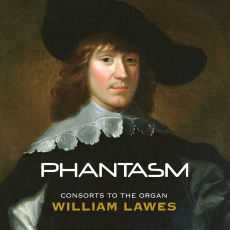Phantasm - Lawes: Consorts to the Organ - ARG
William Lawes (1602-45) was the son of a lay vicar of Salisbury Cathedral. His music gifts attracted the attention of the Earl of Hertford, who arranged for Lawes to be apprenticed to John Caprario and to be a participant in the music at the Earl's Wiltshire estate at Amesbury near Salisbury. In 1635 he was appointed Musician in Ordinary at the court of Charles I, though it is likely that he had participated in court music before that and may have known Charles before he became king in 1625. Lawes was killed in 1645 at the siege of Chester in the English Civil War.
The recording consists of pieces for five or six viols with organ. They were begun in 1636 and completed in 1639. The music is organised in seven sets of three or four movements in the same key. The organ parts are fully written out. They generally double the viol parts, but there are rare moments when the organ has independent material. 9 of the 23 movements are fantasias, the pre-eminent genre of English consort and keyboard music, whose point of departure is imitative counterpoint but can develop with great variety and freedom according to the imagination of the composer. The other movements include airs of varying character and several solemn pavans. The final movement of the six-part Set in B-flat is an In Nomine,a distinctly English genre of cantus firmus composition that traces its origin to John Taverner's Mass Gloria Tibi Trinitas. Lawes's In Nomine may be said to add new shades of meaning to the word serene.
This music was most likely intended for the king's private apartments rather than for public occasions. Laurence Dreyfus, director of the viol consort Phantasm and treble violinist for this recording, claims in his notes that the private nature of the setting gave the composer greater freedom than he would have had in composition addressed to a large audience. This is music intended for the delectation of discerning participants. At its best consort music has a quality of intimate conversation among friends that we as listeners are privileged to overhear.
In his notes Dreyfus continually stresses, often very fancifully, the strangeness of Lawes's music. He says, for example, ‘These works, the pinnacle of Lawes's achievement, are for many an acquired taste, for in each of his sets the composer goes out of his way to alienate both players and listeners, at least before one decides to enter into Lawes's zany universe'.
The validity of Dreyfus's assessment depends to some extent on one's perspective. Lawes's music will certainly seem bold, perhaps even reckless from the perspective of conservative textbook counterpoint of the 16th and early 17th Centuries, but it is more understated than, say, the strained eccentricities of Gesualdo. I doubt that Lawes will sound extreme to a modern listener. His cross-relations, unconventional dissonance treatment, and angular points of imitation undoubtedly raised eyebrows in his day, but our ears have heard Beethoven's Grosse Fuge. I find his music irresistibly attractive not because he thumbs his nose at convention but because his boldness is clearly at the service of a profound artistic vision that found its ideal vehicle in the intimacy of the consort. He does not give the impression that he is breaking the rules just for the fun of breaking them or producing strange harmonies for their shock value. The variety of mood and character from one movement to another is astounding. This is music of great subtlety and richness that will repay repeated hearings.
The performances here are excellent and the recorded sound rich and warm. The players display a keen sense of phrasing that is almost vocal in character. Their readings are shapely and eloquent without resorting to anachronistic exaggeration. Some years ago I came across a disc of much the same music performed by Paul Nicholson and Fretwork. I greatly admire those performers, but that recording did not make much of an impression. Those performances are very good, but they came across as expertly rendered early music as usual. Phantasm on the present recording is decidedly more animated and engaging. The difference is like the shadowy black-and-white reproduction of the composer's portrait on the older recording as compared with the warm colour reproduction of the same portrait on the cover on the present one.
Phantasm founded in 1994 by Laurence Dreyfus, is one of the outstanding ensembles of its kind. They have been based at Oxford University since 2005, when they were appointed consort in residence at Magdalen College, Oxford. Organist Daniel Hyde was appointed organist and Informator Choristarum at Magdalen in 2009.

